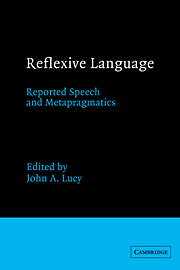Book contents
- Frontmatter
- Contents
- Acknowledgments
- General introduction
- Part I Theoretical foundations
- Part II The relation of form and function in reflexive language
- Part III Text, context, and the cultural functions of reflexive language
- Introduction to Part III
- 7 Generic versus metapragmatic dimensions of Warao narratives: who regiments performance?
- 8 Performance form and the voices of characters in five versions of the Wasco Coyote Cycle
- 9 The represented functions of speech in Shokleng myth
- 10 The political function of reported speech: a Belauan example
- Part IV Interpretation, reported speech, and metapragmatics in the Western tradition
- Name index
- Subject index
9 - The represented functions of speech in Shokleng myth
from Part III - Text, context, and the cultural functions of reflexive language
Published online by Cambridge University Press: 22 January 2010
- Frontmatter
- Contents
- Acknowledgments
- General introduction
- Part I Theoretical foundations
- Part II The relation of form and function in reflexive language
- Part III Text, context, and the cultural functions of reflexive language
- Introduction to Part III
- 7 Generic versus metapragmatic dimensions of Warao narratives: who regiments performance?
- 8 Performance form and the voices of characters in five versions of the Wasco Coyote Cycle
- 9 The represented functions of speech in Shokleng myth
- 10 The political function of reported speech: a Belauan example
- Part IV Interpretation, reported speech, and metapragmatics in the Western tradition
- Name index
- Subject index
Summary
Two kinds of functions of discourse can be distinguished. First, there are the meaning-bearing or signaling functions. These have to do with the contributions of a given stretch of discourse to the communication of which it is part. For example, verb forms may distinguish whether a sentence is to be understood as declarative or imperative. The key characteristic of the signaling function is that meaning is directly encoded in, and read off of, some aspect of the form of the utterance. Second, however, there are what might be termed the goal functions of discourse, the ways in which speech, as a form of social action, is used to accomplish particular ends that the speaker has (cf. Silverstein 1976). For example, it may be used to build a social alliance or to provoke or to obtain information. One characteristic that differentiates goal functions from signaling functions is that the goal function is usually not itself independently specified in the form of the discourse. We must infer such functions from observation of the role of discourse in ongoing social life.
But if we see goal functions as pertaining primarily to the wants and needs of individuals, we must distinguish these from a third type of discourse function, namely, cultural functions.
- Type
- Chapter
- Information
- Reflexive LanguageReported Speech and Metapragmatics, pp. 241 - 260Publisher: Cambridge University PressPrint publication year: 1993
- 5
- Cited by



